|

December 2007-
February 2008
|
BLACK
HORSE EXTRA
To the Heart of Peace Hoofprints
English Town's Role in Westerns
Horse Sense and Nonsense New Black Horse Westerns
More websites, more blogs. . .
. New forums have emerged lately willing to host a diversity of views on
western fiction. Sadly, the same diversity is not so easily found in the
book-publishing world. A respected Spur Awards winner confesses he no longer
enjoys reading "cookiecutter" traditional westerns while publishers' new releases
consist in large part of reprints of books from earlier decades. The "same
old, same old" continues to give critics of westerns the excuse to ridicule them.
Meanwhile, the Black Horse Western series, published in London by Robert
Hale Ltd since 1986, has been praised for a willingness to incorporate a
wide range of material. BHWs have to date not shied away from presenting
the work of the author who has a fresh angle on the expected staples;
is ready to stand out from the crowd with a little daring -- though never so
much as in Deadwood -- and is keen to satisfy the tastes of changing
times.
In this edition of the Extra, two BHW writers who have coincidentally
spent large parts of their working lives as journalists talk about their
methods and inspirations. Brian Parvin's first book for the line appeared
in 1992; Keith Chapman's, in 1993. Brian has three pen-names; Keith, one.
Brian has written continuously and has completed 48 westerns; Keith's total
is less than half that number. Other differences are almost as easy to
spot.
Keith's article, about the writing of a new Chap O'Keefe
book, Peace at Any Price, speaks about the creation of characters
who can be seen other than as "black" and "white" absolutes, and who undergo
life-changing experiences which he hopes will surprise and sometimes shock.
Not for him (or his readers) the comfortable predictabilities of the old-time,
Saturday matinée cowboy film.
The interview with Brian explains how he picks up on the mannerisms
of the people he meets in real life and uses them to help inspire his fictional
characters. But he also says his readers want a black and white story.
"The villain is very black. The hero is very white." And the outcome of his story is assured
from the start. The getting there is the major issue -- "the beauty of
it".
Keith placed some emphasis on historical setting and research when
writing his latest novel. Brian's readers don't want history, though he
knows he must be careful with the details of weaponry and clothing.
These writers each had two BHWs released this year that were
quickly declared out of stock ("no search results") at Hale's official
website. Keith's Misfit Lil Fights Back was history only
seventeen days after its publication date! Brian's Bluegrass Bounty
disappeared almost as quickly. Clearly, they are keeping the customers happy.
So it isn't a case of one has the wrong approach and the other the right
. . . just a couple of interesting case studies that prove a genre-fiction
line doesn't have to turn a writer into a hack working in the strait jacket
of a single, well-worn formula.
Also in this issue, we are joined by loyal BH Extra contributor Greg
Mitchell with another of his valuable backgrounders. This time it's not
on a gun, but on horses, ranches and cattle. And as always, the Hoofprints
section puts us on the track of those snippets of western news and information
that might otherwise be missed. Everyone's help is appreciated. Please
join in and send your views and news to feedback@blackhorsewesterns.com
|

|

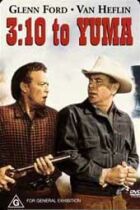
|
Chap O'Keefe maps a BHW's trail
TO THE HEART OF PEACE
Jim Hunter and Matt
Harrison’s Double H ranch thrived . . . till their crew marched away to
war’s glory, and they were ruined by outlaws who burned them out and murdered
the last man on the payroll, harmless oldster Walt Burridge.
When the war ended, the two H’s started over. But for Jim war and the
Reconstruction had wrought changes beyond endurance. His former sweetheart,
pretty Alice Cornhill, had been claimed by another. So Jim rode out and
into the arms of his wartime love, the gun-running adventuress Lena-Marie
Baptiste.
There, he was quickly trapped by his vow to avenge Old Walt. How would
he choose between enmity and love, life and death?
Back cover
Peace at Any Price
THE die-hard followers of the western have had renewed cause lately to
shake their heads in bemusement. Once more the genre has come under
the scrutiny of the Hollywood herd. In particular, director James Mangold's
successful remake of the 1957 feature 3:10 to Yuma had
the movie pundits wondering whether the old shoot-'em-up still had some
life in it.
Could it really be the western hadn't been buried on Boot Hill years
ago?
For the greyer and more cynical, the debate had all the familiarity of
swirling gunsmoke in the last reel. The '80s and the '90s had Tinsel-town
western revivals, too. What the film-makers have tended to forget time
and again is that the traditional western staples are, by themselves, not
enough. Any successful movie has to come with a well-constructed, compelling
storyline, characters whose fates are involving, and a dash of originality.
One of the more perceptive commentators and reviewers it was a pleasure
to read was Bruce Westbrook. In the Houston Chronicle -- after making
the usual observation that Yuma was based on an Elmore
Leonard story -- he stated that the '57 screen version starring Glenn
Ford drew "clear inspiration from the lonely heroics of High
Noon earlier in that decade.
"What made that film a classic wasn't its violent confrontations but its
depth of character, and this new Yuma can make the
same claim," Westbrook said.
"Great western drama doesn't erupt from the barrel of a gun
so much as burn from the depths of a human heart."
|
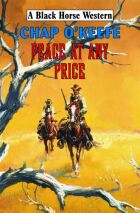


|
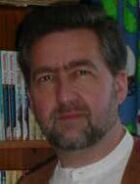
David Whitehead
|
This is a message that the true aficionados have been trying to explain
to the critics and the genre's detractors for years. Here, at Black
Horse Extra, it has been stated by the writers, too -- in particular,
by David Whitehead.
David has said, "The single biggest development has been the awareness
of just how important character is in a story. In the early days, characters
were clear-cut -- with one or two exceptions -- and cardboard in the
extreme. But in the early 1950s a new breed of western writer came along,
and decided to mix a little of the good and the bad into their characters."
The novel Peace at Any Price, which I wrote in mid 2006,
gave me a special chance to explain what we meant, not by a further declaration
of the theory but by demonstration. As soon as the germ of the plot
had suggested itself, and a cast of principal characters was assembled,
I knew Peace
was going to be a book which afforded a better than average shot at crafting
a story which might help support the argument. I hope I haven't squandered
the chance and that the characters capture the interest and sympathy of today's
audience.
The beginnings were not auspicious. When the synopsis was submitted as
a proposal, publisher John Hale had only two comments, and the first
was reserved for the story's setting: "I would prefer the story to be
set entirely after the conclusion of the [Civil] War but perhaps this
is what you already intended."
Well, perhaps I didn't, but no writer of Black Horse Westerns lightly
ignores the preferences of a publisher who has been producing and selling
his line for more than twenty years. For most writers, the synopsis he
or she draws up in advance is seldom an exact outline of the finished
work, and I took heart from Mr Hale's closing remark which was, "Otherwise
I am sure the novel will be your usual splendidly professional and exciting
work."
|
|
|
When I'd written the book, I was able to tell Mr Hale that the War Between
the States features only briefly as a background for Chapter 2, The Breakup
-- less than a fifteenth of the finished work -- and as the background
for a brief, four-page flashback in Chapter 7, Betrayal Under the Stars.
But the war's impact is everywhere, and especially in the raw emotional
torment it brings to the characters' private lives.
Like Mr Hale, and possibly the library buyers on whose opinions he bases his
requirements, I prefer westerns not to have all-out battle scenes of
a strictly military nature. But I can recall, too, satisfactory westerns
where at least the first 20 pages (or reel) are quite thoroughly accounts
of war -- roar of cannon, men wounded and dying, others with swords,
bayonets and guns clashing on bloody fields.
The first chapter of Peace, Black Night on the Double H,
though set at the time of the war, is very traditionally "western". It
describes the destruction of Jim Hunter's and Matt Harrison's Texas cattle
ranch by rustling and arson, but it has no war action, just marginal
mentions of the historical facts. These establish the reasons the ranch
is short-handed and provide the first hints of the all-important catalyst
for Jim's and Matt's split, which is central to the plot.
|

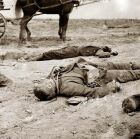
|
|
For five years,
Jim had given the Double H some dash in its dealings with the world. He’d
choose the precarious trail over the safer if it promised more profit
or the spice of excitement. He was happy to leave it to his long-time friend
Matt to supply the partnership venture with stability and security. Truth
to tell, he was drawn by the Confederate cause.
|
|
|
To have set the story entirely after the war would have meant beginning
at Chapter 3, Return to Trinity Creek, and forgoing the chance of a hard-action
opening. This starting-point also would have entailed more than a few
explanatory flashbacks at some stage. In a book of BHW length, too much
backtracking is undesirable and likely confusing. Possibly it can involve
breaking the cardinal "show don't tell" rule as well. For me, a lengthy
report of key incidents delivered in the pluperfect tense as a kind of
synopsis within the body of the main narrative is never an appealing option.
Another solution to time-line problems, and one favoured from time to time by
Hale western writers, is the separate Prologue, but as a reader I find
this trick an uninviting way to open a short book. I want to be caught
up in the main story immediately.
Taken from the dates standpoint alone, the difference in where to begin
Peace was small. Was the start to be during the war,
in late 1863, or after it in April 1865? A choice was made for the former
and accepted.
Mr Hale's second comment was to me the more important, since its subject
was the characters whose hearts and loyalties were going to be tested
and thrown into turmoil by the war.
He said, "It is not particularly clear at the outset who is intended to
be the hero and, of course, an identifiable hero throughout is essential
. . . . Jim does not emerge as the classic hero. Perhaps this is something
you could bear in mind when writing the novel."
I believe I have, though Jim Hunter, like most heroes in O'Keefe books,
is not without flaws. In that sense he still isn't the classic hero.
Jim is "grey" not only in the Civil War context but in terms of a believable
spread of traits, good and bad. As noted previously, successful western
movie-makers and novelists, from Max Brand onward, have eschewed the old,
B-movie "black" and "white" stereotypes.
A novel today demands strong and interesting characters. Once they're
on the scene, it's strange if a plot doesn't grow naturally out of
conflicting personalities. In Peace, Jim, Matt and Alice
Cornhill and their powerful feelings form a tragic triangle. They came
alive of their own accord and it would have been hard to avoid the passion
and the drama springing from their situation.
|

|
|
She could see full
well why Jim was quitting the pain of shared life with his friends on
the Double H; to stay and possibly succumb to temptation would have been
treachery. And she understood all of this so well because her own heart
ached. The sun was rising but Alice felt like it was going down on her
world.
|
|

Candice Proctor
|
A few months ago, at Candy's Blog, writer Candice Proctor (aka C. S. Harris)
wrote about the dread with which many authors view the preparation of
a synopsis. Candy's advice was: "Lie." She told her readers, "Well, maybe
not lie, exactly. Just sort of bend and twist things so that they fit
into an exciting storyline that’s easy to follow despite the fact you’ve
left out suspects, characters, huge chunks of motivation, clues, etc,
etc. . . . Maybe some writers are such gifted synopses-crafters that they
don’t need to fudge a few details. But the fact is, if you’re writing a proposal
for a book that isn’t written yet, the finished product is probably going
to differ in significant ways from your outline anyway.
"So you’re not exactly being dishonest just because you don’t slavishly
follow an outline your editor is never going to see anyway. I’m not talking
about making major changes here. I’m talking about combining two minor characters
into one, or shifting sequences, or simplifying explanations – no more
than it takes to keep from tying yourself into knots and getting bogged
down in details. And who knows? In the process of telling your story in
synopsis form, you may actually find ways to improve your novel."
To this I responded, "A good synopsis on synopses! I say don't dread them,
use them. We had a similar debate here [Candy's excellent blog] when
you raised the question of the Plotter v. the Seat-of-Pantser [the writer
who embarks on a novel without pre-planning].
"Like yourself, I invariably depart from my synopsis in significant
ways, combining minor characters and shifting sequences. For example, in
Peace at Any Price, I decided the heroine's mother was best
dead before the story started, and that her space was better occupied by
a woman friend for the villain.
"And because the book is largely set in a small town on the Gulf
coast, a climax involving a fairly conventional gun duel was given a whole
new look by staging it amidst a hurricane. At the time I prepared the synopsis,
I hadn't even thought about Galveston 1900, so I can't say I deliberately
left that out, but it does illustrate how, with the basics safely taken care
of in the synopsis, you can concentrate on the improvements."
|
|
|
A bad night was
had. Not until early next morning did the fury of wind and water abate,
though the sea’s swells continued and the skies stayed cloudy. Fully two-thirds
of the town was gone. Corpses were washed up everywhere. . . .
|
|
|
Although the famous Galveston hurricane came 35 years after the time of
my story, research produced contemporary acounts that gave me a good picture of
the effects such a catastrophic event would have had on a coastal settlement
of the period.
By the book's end, I think I could fairly say the surviving characters
had undergone life-changing experiences. Much of vital importance had been
at stake for them, and I'd done my best to satisfy the follower of their
trials and shifting fortunes with a fitting outcome.
|

|
|
|
|
 Seeing stars. Seeing stars.
|
A new set of western tracks
HOOFPRINTS
Ray Foster (aka Jack Giles) agrees with our panel (see September edition) that
books come with good covers and bad covers. "My weakness for covers has
more to do with the film images of James Coburn, Clint Eastwood et al -- like Michael Thomas's cover for Ride the Wild
Country which has Burt Lancaster in the closing scenes of the
film Lawman, done in reverse and without the wagon behind
him. Or a book called High Plains Vendetta [by Dale
Graham, 1994] which has a High Plains Drifter-style Clint Eastwood.
Those covers interest me. . . . I have
seen only one cover for a Hale western that struck me as John Turner-esque
and that's Leatherface [by Jack Giles]. As I like
Turner's paintings (which John Ruskin referred to), I liked that
cover. One that left me stunned was the cover to Poseidon Smith:
Vengeance Is Mine [also by Jack Giles]. I don't know the artist but I'm sure he never met my father, and that is who is on
that cover -- and he read more westerns than I could count. We were always
exchanging books." Ray says that after the cover, he looks at the blurb: "I
don't need too much information. So, having dispensed with covers
and blurbs, the books that I buy or borrow have to have grabbed me from
the first page. It's the writing that matters. If I judged a book by
its cover I would never have read Wilbur Smith's first novel; if I judged a book by its blurb then I wouldn't have read many authors at
all."

|
|
|
Missouri Secretary of State Robin Carnahan continues to
manage her family’s 900-acre farm and Angus cattle operation. She has also
helped modernize and strengthen Missouri’s public libraries through grants
to improve access to information using technology. A page at her SOS website
is headed "Western Fiction in a Series". It begins, "If you have ever
read a novel that you did not want to end, and you are a fan of westerns,
then this is the bibliography for you!" Nineteen authors are listed, ranging
from Zane Grey and Louis L'Amour to Richard S. Wheeler
and Elizabeth Fackler. Being an American library list, no BHW series
are included, alas. Interestingly, a sentence that appears no less than
eight times is, "Some strong language, violence, and explicit descriptions
of sex." Seems like the fanatically puritan have failed to impose their
repressive will on the libraries of Missouri!
|
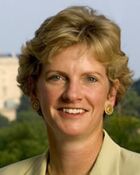
SOS endorsement.
|
 Publishing legend. Publishing legend.
|
Publisher Erastus Beadle (1821-1894) launched his Dime Novel series
in June 1860. During the Civil War, he sent his books to the front in
bushels, alongside food rations, introducing thousands of young men to
the pleasure of reading them. Like today's BHWs they were standardized
products, distinctively packaged and issued to a regular schedule. Dime
novels transformed the publishing industry. The Beadle company, though
much imitated, had published more than 7,000 of them by 1897. Total sales
in the first five years, to 1865, were nearly five million copies. Dime
westerns were also responsible for introducing what in more modern times
has been known as the "docudrama" -- mixing fact with fiction and sensationalizing,
for instance, episodes in the life of William Cody, who was made
famous as Buffalo Bill. Novels about the escapades of Jesse
and Frank James were eventually banned from distribution by the
Postmaster-General of the United States. The argument was that they turned
outlaws -- still living at the time and still dangerous -- into heroes.
|
|
|
Ready to take a joke? In a satirical article in the British Telegraph
newspaper, Craig Brown listed "14 Things You Didn't Know about the
Western". A couple of rib-tickling samples: "Between 1860 and 1890, baddies
in the Wild West were legally required to wear black hats, so that they could
be identified as they rode into town and shot on sight. Similarly, all ladies
working in bordellos were required to undertake regular medical check-ups
to ensure that they still had hearts of gold." And: " Russell Crowe's
new 3:10 to Yuma is, in fact, a remake of 4.50 from
Paddington. Crowe's role was taken in the original by the redoubtable
Dame Margaret Rutherford." Elsewhere in the Telegraph, Sheila
Johnston reported under the heading Letters from America: the Western
Revival: "Today the western is back in town, all guns blazing. Last year's
Brokeback Mountain, Tommy Lee Jones's Three Burials
and Australia's The Proposition were just the opening shots.
Liam Neeson and Pierce Brosnan saddled up last month for
Seraphim Falls; currently 3:10 to Yuma tops
the American box-office charts."
|
 Pistol-packin' Margaret. Pistol-packin' Margaret.
|

Bob . . . multi-tasker.
|
Blazing into the global town that's the Internet came Saddlebums Western
Review, launched in late August by Gonzalo Baeza and Ben Boulden
after discussion at another blog. Ben said, "Saddlebums is the place
for news about the western genre." His premiere post attracted 35 welcoming
comments, including several from the BHW community, though an attempt to
unsaddle Saddlebums supporter Chap O'Keefe -- whom some have felt compelled to regard as a bête noire -- saw the near-anonymous
instigators fall on their faces. Ben concluded, "Chap is absolutely right
when he said 'This forum is for open discussion. It is not a behind-closed-doors
place. Nor, as far as I know, will anyone try to suppress you or your views
here.' Everyone is welcome, as well as their views and ideas." Only private grievances were ruled out. To continuing
acclaim, Ben and Gonzalo went on to review a fine range of books and to
interview top writers. The lineup included Brian Garfield,
Robert J. Randisi and Johnny D. Boggs. The versatile and prolific
Bob Randisi told Saddlebums, "I have a TV in my office, so I usually watch
while I’m working. Last week I watched all three Magnificent
movies on tape while I worked on a western. Also some old Warner Bros. westerns
like Cheyenne and Maverick. Then, while working
on a mystery, I’ll watch some Sunset Strip or Hawaiian
Eye tapes, maybe some British mysteries or movies, like Tinker,
Tailor, Soldier, Spy, or American films like Harper
or Chinatown."

|
|
|
Two mass-market Berkley paperbacks published by Penguin Group USA in
2001 and 2002 have been reissued as BHWs for the UK library market. They
are Winter Kill and Dead Man's Journey by Frank
Roderus. The author says he wrote his first story -- a western naturally!
-- when he was five and has never had any ambition since but to write for
a living. He has been producing fiction full-time since 1980 after a career
in newspaper reporting. As a journalist, he won the Colorado Press Association's
top award, for Best News Story, in 1980. The Western Writers of America
has twice named him a recipient of their prestigious Spur Award. In 1983
he won the Best Novel award with Leaving Kansas and in 1996
he won the Best Paperback Original award for Potter's Fields.
Frank is a lifetime member of the American Quarter Horse Association. He
now lives in Florida and, with his wife, Magdalena, plans to divide
his time between Florida and Palawan Island in the Sulu Sea.
|
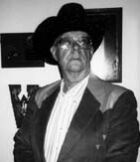 Spur winner reissued. Spur winner reissued.
|
 All-rounder's work.
All-rounder's work.
|
BHW author David Whitehead (aka Ben Bridges and Matt
Logan) was another pleased by the Extra's last edition. "I wasted little
time in getting to the latest BHE. Yet another triumph! Absolutely packed
with news and as usual quite beautifully presented. . . . The forum idea
[on book covers] worked well, and I found the article on artist Michael Thomas
of great interest. By coincidence, I'd just received a few copies of my
large-print Janet Whitehead romance A Time to Run from
Linford publishers F. A. Thorpe and was startled to find that he had painted
the illustration for that, too. . . . Thank you yet again for your sterling
efforts to promote our genre. It may be a cliché, but BHE really is
going from strength to strength, and I feel that this may be the
best issue yet."
|
|
|
As the western shot its way back on to the big screen this year, director
James Mangold told San Jose Mercury News correspondent Jeff Anderson
how he couldn't sell the idea of a 3:10 to Yuma remake to
any studio. "No one wants to make westerns. We got financed by a bank, and
they sold it to Lionsgate while we were in production," he said in San Francisco.
"I think the western has gotten really misunderstood lately. People view
them as kind of a period picture, or a historical picture. I think they're
a kind of a fever dream. They have as much in common with science fiction
as they do with The Age of Innocence." With the Yuma remake
a box-office hit, Mangold was confident the western could catch on again.
"As long as people like Johnny Cash were embraced, a western can be.
It's really about truth -- bare-bones truth." Mangold was
accompanied to 'Frisco by Peter Fonda, who plays bounty hunter Byron
McElroy in the movie about a rancher's attempt to bring an outlaw to
justice. Fonda said the western was "a wonderful way to tell stories about today. You're tricked
because you only see it afterwards. While you're watching, you're not thinking
about Iraq. This is what elevates it beyond other kinds of movies."

|
 Studios' cold shoulder. Studios' cold shoulder.
|
 Bid to be fresh. Bid to be fresh.
|
Multiple Spur Award-winning author Richard S. Wheeler voiced disenchantment
at the Saddlebums and Ed Gorman blogs. "I'm going to get myself into
serious trouble with western readers and confess that traditional westerns
have worn out their welcome in my reading pile," he said. "I love to write
them because I can attempt something novel and fresh; I don't love to read
them any more, and sometimes I simply hate the damned things." And: "I had
occasion recently to read a classic gunfighter novel by a very successful
western novelist. It carefully strung together every cliché of that sort of
story ever invented. . . I try not to write or read cookiecutter stories,
so they mystify me, along with those who read them." Meanwhile, a list of
westerns for October leaned heavily on reprints of classics by the likes of
Bret Harte, Clarence E. Mulford and Zane Grey. Except for BHWs, the smattering
of genuinely new entries consisted almost entirely of the latest titles in
anonymously written, house-bylined series.
|
|
|
BHWs' print-runs are calculated primarily to fill the requirements of
libraries in Britain and Commonwealth countries, many of which have standing
orders for new releases. Consequently, titles that prove popular also present
supply problems for the publisher and the distributors. Among the recent
books that have fallen into this class are the Misfit Lil stories.
The good news for readers who have enquired is that the first book in the
series, Misfit Lil Rides In, originally published in July
last year, is now available again everywhere -- US included -- in a large-print,
trade-paperback edition from Dales Westerns (Ulverscroft). The new book has
impressive cover art by Gordon Crabb. Gordon is one of the most highly
respected cover artists active in the UK today and has also worked consistently
for US publishers, including Bantam, Dell, Daw and Tor Books. Dales have
also just reissued the out-of-print BHW The
Lawman and the Songbird, featuring Joshua Dillard. Next year, among others, Dales has the
latest Dillard book lined up; Sons and Gunslicks appeared
as a BHW in March and was another title that quickly went out of
print at the publisher's. And a diary note for those determined not
to be disappointed is that the fourth Lil BHW, Misfit Lil Hides Out,
will be published by Hale next March.
|
 Second chance. Second chance.
|
|
|
|
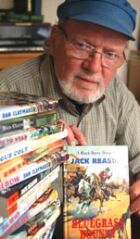
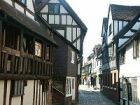
Shrewsbury

|
Brian Parvin's real-life sources for characters
ENGLISH TOWN'S ROLE IN WESTERNS
Dawn came up
that day in the town of Random on a bad note. They found a respected local
man dead, hanged by the neck from the tree in the livery corral. And things
were about to get worse with the discovery of the victims of murderous slaughter
and rape at a nearby homestead.
Were the two events linked? Was a bunch of crazed killers
on the rampage; a lone gunman hell-bent on some personal retribution? The
days that followed drifted from fear into nightmare as the town and its
folk fell prey to the torment of Edrow Scoone and his ruthless sidekicks.
But then a stranger, scarred and silent, booked himself
a room at the Golden Gaze saloon.
Back cover
Mist Rider
BLACK Horse Westerns are written by authors around the
world, including the United States, Australia and New Zealand, but with
the books published primarily for the UK library market, it's not surprising
the largest contingent is based in Britain.
Brian Parvin, who writes his
westerns as Dan Claymaker, Jack Reason and Luther Chance, hails from Shropshire,
a county in the west of the English Midlands, bordering on Wales. It is
fine pastoral country with hills and woodland, agriculture and dairying.
Brian -- and Dan, Jack and Luther -- live in its beautiful, medieval market
town, Shrewsbury.
Shrewsbury was listed as Brian's home in the old Hale print catalogues
which predated the helpful new company website. His first western, Rain
Guns by Dan Claymaker, was published in 1992. Before that, he had
written science fiction, fantasy and wildlife stories.
His 1986 novel The
Singing Tree was a post-holocaust animal fable about a quest by
a fox. It was described as "a dramatic story of love and survival that
celebrates the affinity between wildlife and humanity . . . and our future
together". Other similar novels under his own name were The Golden
Garden (about hedgehogs, 1987) and The Moon-Keepers
(about badgers, 1988). All were published by Hale.
|


|
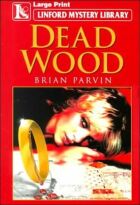

|
Brian's work has also included mystery fiction and the following titles:
The Deadly Dyke (1979), Death in the Past (1980),
Dead Wood (1980), Then There Was Murder (1981),
Dawn Boys (1989) and Wreath for a Ragman (1999).
As the Hale company withdrew from some genres and expanded its BHW list,
the author switched to westerns and has now written 48. Despite his crime
fiction writings, Brian's westerns do not have any emphasis on mystery. His
books for the genre cannot be categorized as "crossover" novels. In August
he was interviewed by Tony Neal for his local newspaper, the Shropshire Star,
whom we thank for some absorbing insights to the writer's career and modus
operandi.
Brian believes, "The readers want a black and white story. The villain
is very black. The hero is very white. And good will undoubtedly triumph.
It has to. That’s the beauty of it as far as I’m concerned. It’s got
a great moral message. They know who is going to die within about four pages.
They know, probably within ten pages, who is going to do the killing.
It’s the getting there that’s the major thing. That’s the beauty of it.
How is the hero going to do it when the odds are stacked mercilessly against
him?"
Brian, a retired journalist, follows the old advice of drawing his fictional
characters from real life. He pays special attention to uncommon gestures
and mannersisms. To folk in the very English county town of Shrewsbury
it must have come as a surprise when the Star reported they could have
fictional counterparts striding the old American West!
|

|
|
It is not that Brian bases his heroes and villains on the people he meets
day to day, but like an old-time stamp collector perpetually adding new
specimens to fill blanks in his album, he seeks out and takes note of
the distinctive mannerisms, gestures and little traits that add up to make
a memorable individual.
"I don’t think anyone would obviously recognize themselves. But there are
certain characteristics. I don’t suppose they’re peculiar to Shrewsbury. You
could not take a whole person. You would never be able to interpret that person
because you would never get to their soul. What you can do is take a part,
a portion -- a mannerism is the word."
Brian seizes on a main characteristic and it becomes the vivid touch for
which he lets a principal in his story depend for realism. It's an old,
old trick to fix the character in the reader's mind. Done judiciously, it works.
One of his westerns pulled from the shelf at random illustrates the technique.
The Gun Master by Luther Chance is set in the small town of
Peppersville -- a much-modified Shrewsbury? -- which is awaiting attack by
the murderous Drayton Gang. The only top gun in town is a stranger called
McCreedy. We learn little about him and even at the book's end, he remains
largely a mystery without so much as a first name. This author, remember,
isn't out to challenge our grey cells.
|

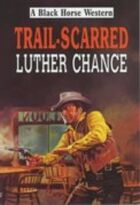
|
|
What we are given to enjoy is a gallery of fearful
townsfolk, each defined by a key mannerism. Undertaker Ephraim Judd is
given to peering dolefully over his polished pince-nez. Storekeper Byron
Byam grips the lapels of his tailored frock coat. Preacher Peabody clears
his throat carefully but deliberately, or coughs, before speaking. And
so on. Members of the Drayton bunch, when they arrive, are given
to spitting -- a lot. (Spitting is a common habit in the West of Brian's books
but we're sure it's not on the streets of Shrewsbury!) Readers are reminded
about these things from time to time, and it keeps them clear about who's
who. They are not greatly distracted with characters' back stories, private
agendas or deeper motivations. Chapters are swift bites, mostly of six or seven pages.
But paradoxically, Brian’s favourite movie is Shane -- the
classic, one-man-against-the-odds western in which characters are not
of the black-and-white variety and the story is emotionally and morally complex.
The old western movies clearly have a nostalgic appeal. Brian told the
Star, "When I first met my wife her passion was westerns. If we went to the
flicks, as they were known in those days, she would choose a western. I
thought, that’s something I have never done. Could I do it? Could I write
a western? And I did."
Today, his wife continues to play a vital support role in the production
of the Parvin westerns. He writes first drafts in longhand, and she types
them up. "It’s a partnership, a team effort," he said.
Brian maintained that he takes on a different identity for writing under
each of his pen-names. "Dan [Claymaker] is the thoughtful one. Jack [Reason]
is the man of action, for want of a cliché. Luther [Chance] has a slightly
humorous side. He sees the funny side of things. As my wife says, she has
been married to four men for a long time. She never knows quite who she
is waking up with."
|

|
|
What is not in doubt is the four's mutual approach to the western. Readers
and other authors have recently contended the western should be breaking
out of its narrow, classic form. They point out that for variety you don’t
need to go further than actual history and the numerous historical episodes
and characters that haven’t been dealt with so far in the fiction of the
West. But Brian had a warning about delving into parts of the West's rich
history that haven't been tapped:
"As a writer of westerns you have to be very careful. If you try to write
a history of the real West, then you are not appealing to your western
reader. He knows a fair bit about these frontiers, Indian wars, wagon trains,
and crossing the great plains, but he doesn’t really want to be told about
that."
For readers of the genre, there were certain expectations and conventions,
he said. It was a romanticized, fictionalized version of the American
West.
While readers didn’t want history, Brian could not be careless with the
details. "My readers will quickly pick up anything that’s loose in the
form of weaponry, such as a Colt or a Winchester repeating rifle. All
these things you have to be careful about. Similarly with clothing. Broad-brimmed
hats. Never say trousers -- always pants. And so on."
Unlike many of his writing colleagues, he is qualified to speak about
the use of guns in conflict, having served with the Gurkhas in Malaya.
He has vivid memories of some hard-kicking military firearms. "I can tell you one thing -- recoil is phenomenal."
|


|
|
What he has not done is visited the places that today occupy the mythical
territory of his books.
"I have travelled in many countries throughout the world, but have never
been to the American states. And sometimes I feel a little bit fearful
about doing it. If I went out there, I would certainly want to go right
into the Mid West, and I just wonder whether I would be a bit disillusioned.
Would Utah seem quite as Utah seems to be in my books?"
|
|
|
|
|

|
Greg Mitchell rounds up broncs, ranches and cattle
HORSE SENSE AND NONSENSE
The sheriff turned to
the middle-aged man riding beside him."Harry don't seem to be too worried."
Those were the last words that Henderson ever spoke.
King Leslie fired from concealment and put a rifle bullet between
his eyes. The posse was now in a trap and the outlaws closed it. Rapid, close-range
fire poured in from three sides. The surprise was complete and its effect
devastating. Men were smashed from saddles, horses reared over and fell backwards
or collapsed as though their legs had been swept from under them. A few fired
back at the puffs of gunsmoke spouting from among the rocks but most wheeled
their mounts and fled back the way they had come. The slaughter was unrelenting.
Some threw up their arms and fell from their mounts, others slipped off quietly
as though they had fallen asleep. Wounded men clung to saddle horns as they
fled with all thoughts of fighting gone. Now only survival counted.
Killer's Kingdom
Greg Mitchell
THE other night I was reading the comment about black horses (the real
ones) that headed the article "Judging Books by Their Covers" in the last
Black Horse Extra. I found myself agreeing. I've ridden a lot of black horses
at different times and have encountered some good ones but none that I would
call outstanding. They have to be taken as you find them.
In my younger days, when I was employed on the massive, unfenced cattle
properties of Australia's north, I always worked on the assumption that
a good horse was never a bad colour, but was wary of piebalds and skewbalds
(paints, pintos etc.) mainly because the two best riding breeds, the Arab
and the Thoroughbred, do not have these colours.
Broken colours indicate inferior breeding, and breeding is important
in terms of a horse's weight-carrying ability and endurance. A well-bred,
medium-sized horse can carry weight better than a coarsely bred animal that
may be half-draught. and a couple of hundred pounds heavier. Though it's
not my favourite color, the really outstanding horses I've had have all
been bays.
The wandering cowboy of fiction seems to be able to carry all he needs
on his riding horse. In reality, not much can be packed on a saddle even
with a pair of large saddlebags. A single blanket takes up a lot of room
and the bedrolls carried by cowboys in cold country were far too large
to carry on riding saddles. Coffee pots and frying pans are particularly
awkward. The real howler, still appearing in books, is when the hero cooks
himself bacon and eggs for breakfast. Eggs are not designed for carrying
on horseback.
It would be possible to travel from town to town and stay overnight
in hotels, but that would also be expensive. A man could spend a night
out in the open with just what he could carry on his saddle though it
would not be a comfortable night, especially in cold or wet weather. When
travelling where towns were more than a day's ride apart, most westerners
would use either a horse or a mule as a pack animal. From an author's
point of view the presence of pack animals can hamper a character's movement
so it makes sense to leave them out, but the real wandering cowboy would
use them.
|
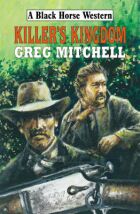
 Paint
Paint
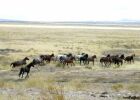 Mustangs
Mustangs
|
|
A lawman, a farmer, or someone based in town might ride the same
horse all the time but cowhands on big ranches and trail drivers changed
their mounts daily.
Mustangs
were plentiful and cheap but many were too light for roping. Likewise,
they were too light for cavalry use as the average cavalry load of 240
pounds was out of proportion to their bodyweight (700-900 pounds). Their
light weight also worked against them when roping heavy cattle. Indians
got good mileage from mustangs because they carried little on them and changed
them often.
Quarter horses had the weight averaging around 1,175 pounds
and had plenty of short-distance speed. On rough ground, where they could
not use their long, low stride, other horses were just as fast and some
had more endurance.
Draught horses were unsuitable mounts for big men. Draughts
have too much of their own weight to carry, are rough to ride, can be
clumsy and lack stamina at faster paces. With body weights from 1,600 pounds
to more than 3,000 pounds, their different bone structure makes them unsuitable
for riding.
Arab horses were good but were not common in the Old West. Though
usually bigger than mustangs, 15 hands is fairly big for an Arab horse.
Weight can be 900-1,000 pounds.
Morgan horses weighed slightly over 1,000 pounds and were
riding or light harness types. Despite what is often written, they were
not used to pull heavy wagons. Some were used in light harness for buckboards
or buggies but they lacked the size for heavy draught work.
|

Quarter horse

Draught horse
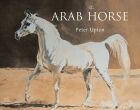
|
|
Thoroughbreds were the favoured mounts of many army officers and
proved their ability on a great number of nineteenth-century battlefields.
The breed should not be judged by the broken-down fugitives from race tracks
that today give such an unfavourable impression of these horses. No other
breed of horse can carry even the light racing weights at the same speed
or over the same distances. With an average height of about 16 hands and
mostly weighing between 1,050 and 1,200 pounds, they had the size to make
them good weight carriers. Thoroughbreds of good conformation, properly
acclimatized to the country, are very good workers indeed.
Stallions are often selected as mounts for fictional heroes,
but they are a bad choice to ride. They will fight other horses if there
are mares about and if they are near a mare in season they are prone to
forget what their riders want. A stallion hitched to a rail in a town
would cause no end of trouble and would be most unlikely to wait patiently
at the hitching rail while his master disposed of the villains. The army
never used stallions except on breeding establishments.
|

Morgan horse
|
|
The outlaw King
Lesley set up his kingdom in the San Christobal
Mountains. From there, he plundered the countryside around Henly Springs for
two years. Finally the townspeople pressured their local sheriff into leading
a posse against the outlaws. But they were ambushed by Lesley's men and a
massacre ensued. Was salvation at hand when Marshal Rod Delroy arrived in
town with the mission of rescuing any survivors? The issue was complicated
by the intervention of Mort Wolfe, a man driven by his desire for revenge
against Lesley. Rod faced many dangers before the outlaw threat could be removed.
Back cover, Killer's Kingdom
|
|
|
Ranches and cattle
Large ranches would never have had an accurate count of the number of
cattle they had on the open range. They were mixed in with other brands
until roundups in spring and autumn, where calves were branded and stock
selected for sale. Local ranches were all represented at roundups. There
was little point in rustlers running off herds of branded stock. They
would be hard to hide and difficult to sell unless brands were somehow
altered. Cattle were earmarked as well, and an earmark was often harder to change
than a brand. Most rustlers concentrated on stealing unbranded calves.
In the years following the Civil War it might have been possible to sell
stolen, branded cattle, but the ranchers soon devised means of dealing with
the problem with properly registered brands and earmarks. Altered brands
could be seen on the flesh side of the skin when the animal was killed.
Night watches were kept only on trail herds. Ranch cattle were not
coralled every night, so when rustlers struck it was often difficult to
know how many head were missing. Successful rustlers usually needed a
few days' start if they hoped to escape with a large number of stolen cattle.
Cattle tracks are almost impossible to hide and splattered manure as opposed
to one neat pile advertises to all that animals are being driven.. The often-described
trick of concealing tracks in streams would not work very well as it
would be hard to hold a large number of cattle in a stream and they would
make very slow progress. Vengeful ranchers would see where the herd went
into the water and it would not be difficult to find where they came out
again.
Most ranchers preferred the open-range system because they could run
far more cattle than their relatively small ranches could carry. One
cattle baron with hundreds of thousands of cattle actually owned only
18 acres of land. But when it suited their purposes, the ranchers would
use barbed wire as readily as the small homesteaders. Not all of the latter
were hard-working, god-fearing folks and some would often claim virtually
worthless land at strategic places to gain control of vital water or to
extract tolls from the big Texas herds moving north. This practice contributed
greatly to the demise of the traditional cattle trails. Conversely, the
big ranchers were too quick to brand honest homesteaders as rustlers.
There were good and bad on both sides.
|



|
|
Despite the paranoia about sheep, and what is often claimed, sheep and
cattle can graze on the same pastures. In many countries of the world,
they do. Sheep, however, can eat lower than cattle and an area over-grazed
by sheep can be badly damaged. The most important part is to avoid over-grazing
by either species. Under the open range system, sheep were shepherded continuously
while cattle were left to fend for themselves. If sheep ate all the feed
in one area, it meant that the cattle had to travel further afield for grass
and walked condition off themselves in the process. It also made them harder
to find at roundup time. In the sheep or cattle controversy, neither side
showed any great desire to compromise. The ranchers had the men and guns
and it suited them to vilify sheepmen to force them off the range. The sheepmen,
in turn, could destroy large areas of land if they held their flocks too
long in the one place -- and they did have a tendency to do this.
-- Paddy Gallagher, aka Greg Mitchell, whose
next BHW will be Range Rustlers.
|
|
|
|
|
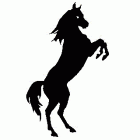

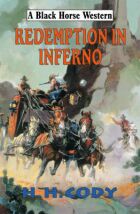
|
NEW
BLACK HORSE
WESTERN NOVELS
Published by Robert Hale Ltd, London
978
| Peace at Any Price
|
Chap O'Keefe
|
0 7090 8269 9
|
Running Crooked
|
Corba Sunman
|
0
7090 8415 0
|
Dead Man's Journey
|
Frank Roderus
|
0
7090 8431 0
|
| Killer's Kingdom
|
Greg Mitchell |
0
7090 8459 4
|
Redemption in Inferno
|
H. H. Cody
|
0
7090 8488 4
|
The Bounty Killers
|
Owen G. Irons
|
0
7090 8489 1
|
Manhunt in Quemado
|
Daniel Rockfern
|
0
7090 7686 5
|
Desolation Pass
|
Lance Howard
|
0
7090 8328 3
|
Hammer of God
|
P. McCormac
|
0
7090 8490 7
|
The Bull Chop
|
Abe Dancer
|
0
7090 8492 1
|
Wilde Country
|
Tyler Hatch
|
0
7090 8499 0
|
Judge Parker's Lawmen
|
Elliot Conway
|
0
7090 8500 3 |
Guns Along the Gila
|
Walt Masterson
|
0
7090 8478 5
|
Gold for Durango
|
Carlton Youngblood
|
0
7090 8501 0
|
Tough Justice
|
Skeeter Dodds
|
0
7090 8502 7
|
Dead Man Walking
|
Ethan Flag
|
0
7090 8509 6
|
Mistake in Claymore Ridge
|
Bill Williams
|
0
7090 8504 1
|
Last Stage to Lonesome
|
Scott Connor
|
0
7090 8510 2
|
|
|
|
|

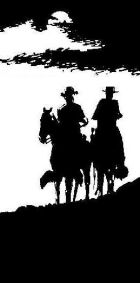
|

|
Black
Horse Westerns can be requested at public libraries, ordered at bookstores,
and bought online through the publisher's website, www.halebooks.com, or retailers including Amazon, Blackwells,
WH Smith and VinersUK Books.
Trade inquiries
to: Combined Book Services,
Units I/K, Paddock Wood Distribution
Centre,
Paddock Wood, Tonbridge, Kent TN12 6UU.
Tel: (+44) 01892 837 171 Fax: (+44)
01892 837 272
Email: orders@combook.co.uk
For Australian Trade Sales, contact DLS Distribution Services, tradesales@dlsbooks.com
For Australian & New Zealand Library Sales, contact DLS Library Services, swalters@dlsbooks.com
DLS Australia Pty Ltd, 12 Phoenix Court, Braeside, 3195, Australia.
Ph: (+61) 3 9587 5044 Fax: (+61) 3 9587 5088
|
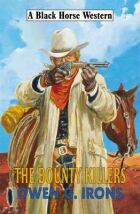
|
|
|
|
|